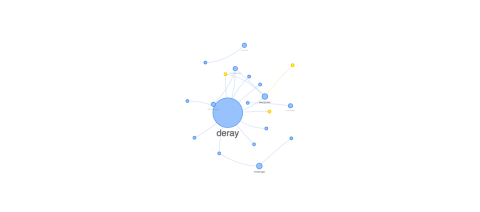For Method 4, I used a 48 hour time frame from November 24th at 6:00pm to November 26th at 6:00pm. I chose this time frame due to my interest in the initial reactions of Twitter users after the final verdict of Michael Brown’s death was released. Following the decision, much of the public was outraged and took to the streets to protest. The keywords that I used in my search were “riot” and “protest.” Through my search, I was hoping to discover who was leading the conversation around the protesting in the days following the release of the grand jury’s verdict. I also decided that I wanted my network to include “Text Only” media, as my focus was conversation. Once this was done, I began to analyze the network map I had created.
My search gathered 135 tweets with 20 different Twitter users in the network, including 13 activists and 7 journalists. Looking directly at my network map I noticed that most of the pods, representative of Twitter users, were interconnected with @deray, a very involved activist throughout the movement in Ferguson. @deray held the biggest influence with 20 reactions. Although they were connected to @deray, there were very few users that branched out to other users connected to him as well. This is also referred to as ‘one way’ users. Most of @deray’s tweets revealed details regarding location and time of a set protest, as well as sharing his personal feelings about the movement. My results also showed that @deray’s reach was larger than any other user in this network.
The users who were reacting to @deray’s tweets were typically activists. I also discovered that when journalists were tweeting, it was actually activists that were more likely to react to the subject than fellow journalists. My small data set showed that no journalists responded to a tweet posted by an activist. At this point in the trial of Michael Brown’s death, most of the users in my network map were discussing the interactions between law enforcement and protestors as well as the progress of the movement.
The network map gave me the ability to view connections between different users. It allowed me to see which users were seen as influential during the Ferguson movement and who was able to see these kinds of tweets. Typically, @deray would tweet and then activists in his network would retweet what he had posted instead of posting original tweets. This snowball effect circulates tweets, creating a network. While looking at my network map I noticed that Antonio French was not present in my network. This was surprising to me, considering that French had been an extremely influential figure throughout the entire movement. Overall, the network map provides a “bird’s eye view” to see the interconnectivity of users and how they interact with one another.
- Log in to post comments
